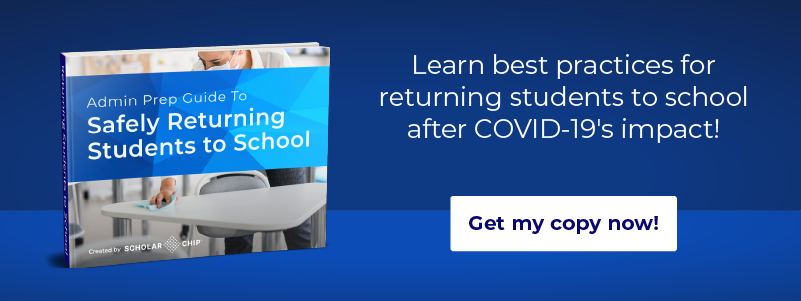Across the country, school districts began shutting down their buildings mid-March 2020. At the time, it seemed an extreme but temporary measure necessary to slow the spread of the coronavirus. Most districts believed that they would be able to reopen within a few weeks, possibly after the spring recess. However, mid-April saw governors extending “stay at home” orders as the number of new infections continued to rise. By the end of May, officials in forty-eight states, the District of Columbia, and all five US Territories decided that for the safety of students, school personnel, and the communities they serve, school buildings must remain closed for the remainder of the 2019-2020 school year.
The challenges to school administrators are new. The sudden shift to remote learning and online meetings and the difficulty of trying to create a budget and figure out a safe way for taxpayers to vote on said budget have left little time to think ahead to reopening plans. Some states are planning to reopen schools as early as August. After months of urging people to “stay home to stay safe,” what will it take to improve community trust in safety?
Understandably, the thought of sending their children back to school can make parents uneasy. Teachers and staff may also be concerned about their own health. However, several European countries have reopened schools without experiencing a rise in coronavirus cases. We may take lessons from them when developing reopening plans. Each district must also consider the unique qualities of their schools and their students. To assuage fears, districts must treat all stakeholders as partners. Opaqueness will only increase people’s anxieties. School leaders must keep lines of communication open and explain the rationale behind safety measures through each step of the district’s reopening plan.
1) Create a reopening plan outline
It has been a century since the world has had to deal with a health emergency of this magnitude. We are all novices when it comes to reopening schools. Similar to an Emergency Operations Plan, a reopening plan must detail the actions that are necessary to keep students and school personnel safe. Every district has different needs, but a comprehensive reopening plan should include the following actions.
- Designate a reopening team. This should include all stakeholders, including board members, administrators, teachers, PTSA representatives, and community leaders.
- Develop sanitation and safety protocols. Assign responsibilities for developing procedures, routines, and schedules for disinfecting buildings. Identify necessary PPE (facemasks, goggles, gloves, etc.) when it must be used and who should wear it.
- Design a personnel training program. Determine how staff will learn about district sanitation and safety protocols.
- Create policies for visitors and vendors. Make sure they are well understood by all stakeholders.
- Plan for a response to virus exposure. Be prepared for the possibility that a member of the school community will become infected. Schools may need to evacuate students and staff to sanitize buildings. Plans must also consider the possibility that an outbreak in the community may force schools to shut down for extended times.
- Streamline internal and external communications. Trust requires transparency and timely communications. Develop systems, such as automated calls, phone trees, and email and IM distribution lists, to ensure that all stakeholders stay informed.
2) Make the district website an information hub
The district’s website should be the go-to place for parents and community members who want the most up-to-date information. As schools, districts, and states move forward with reopening plans, there will undoubtedly be setbacks. School leaders may need to quickly revise class schedules, bus routes, and planned events. Although it is common practice to send students home with newsletters, information should also be posted on the school website and cross-referenced on social media to get the maximum coverage. Link to state and federal COVID information websites, and provide a form or chat function for asking questions.
School policies, such as facemask requirements and visitation rules, should be posted prominently. Policies should be written in concise, easy-to-understand language, preferably with graphics and bullet points.
3) Modernize IT systems to better control building activities
Governors are lifting their stay-at-home orders and businesses are reopening, but the pandemic is not over. States that had previously avoided large outbreaks are now experiencing rising infections and hospitalizations. Since we lack a vaccine, containment and mitigation are the only tools available for keeping students and school personnel safe. Updating and integrating the school’s IT systems will increase operational efficiencies, allowing administrators to quickly identify and address problems.
Technology to monitor building activities in order to improve community trust in safety
Automated attendance systems that utilize chip-embedded ID cards provide real-time data on absences, information that is critical to containing possible virus outbreaks. Students and faculty tap or swipe their cards at a card reader to record their attendance. Aggregated attendance data, with identifying information filtered out, may be useful to local health departments as they track illness in the community.
Computerized visitor management systems eliminate pen and paper logs that are inefficient and unsanitary. The most effective systems are capable of scanning drivers’ licenses to verify identity and record who is in the building at any given time. This information is critical for contact tracing purposes.
In addition to health considerations, school leaders must acknowledge the toll that the pandemic has taken on students’ academic progress and their emotional development. The AASA Guiding Principles & Action Steps for Reopening Schools calls on schools to support students’ psychological, social, and emotional needs as they return to class. It requires integrating social-emotional learning with classroom instruction to strengthen a student’s well-being and engagement.
While this is a tall order for teachers and staff who may already be overwhelmed trying to make up for lost time, automated behavior management systems can ease the return to school by offering a simplified way to document behavior, connect with parents, and issue referrals. Systems with self-paced, interactive learning modules give students agency as they develop skills in the social-emotional realm.
4) Gain community support
Schools need their communities to have confidence in reopening plans. Parents and staff may be fearful. To improve community trust in safety plans, citizens must understand the science behind the decisions that school leaders make. Plans must be simple and free of jargon so they make sense to people outside the education field. Posting FAQs on the website, creating webinars to explain reopening policies, or holding Zoom-type conferences to discuss concerns will go a long way toward getting community support for school reopening.
5) Reopen stronger than before
The sudden switch to remote learning this spring revealed inequities in our education system. Students had unequal access to resources. Reopening plans are an opportunity to address learning disparities and other shortcomings. While Multiple Intelligences Theory and diversified instruction and assessment have been central concepts in curriculum building and lesson planning for decades, this may be the time to reimagine how technology, personnel, and community resources can better serve all students.
After months of homeschooling, parents have a new perspective on their children’s education. They may wish to remain involved at a greater level than before. Schools should embrace this positive development and encourage community participation in new initiatives. These efforts will not only improve educational outcomes but also create a strong community partnership.
As districts develop reopening plans, health will be the priority, and school leaders must be up to date on the latest federal and state guidelines. Open communications and modernized IT systems will help build public confidence in the district’s ability to safeguard community health. Reopening is also an opportunity to make schools better, but this only will happen if schools can improve community trust in safety.
ScholarChip offers unique holistic school safety services based on CDC guidelines to help schools reopen amidst growing health concerns. Through our advanced technology, built and designed for the K-12 environment, schools can identify risk and mitigate the spread of infection. Our solution includes fever screening, visitor questionnaires, symptom and vaccine tracking, in-school contact tracing, alerts, and notifications. Learn more about our advanced COVID-19 solutions or request a reopening strategy session today!


